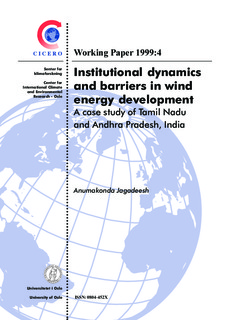Institutional dynamics and barriers in wind energy development: A case study of Tamil Nadu and Andhra Pradesh, India
Working paper
Permanent lenke
http://hdl.handle.net/11250/192438Utgivelsesdato
1999Metadata
Vis full innførselSamlinger
- CICERO Working Papers [167]
Sammendrag
Tamil Nadu state had 719 MW of windfarm capacity by September 1998 out of the country’s total figure of 992 MW, while Andhra Pradesh had 58 MW installed capacity. 1995-96 saw a boom when 282 MW windfarms were set up in Tamil Nadu and the capacity in Andhra Pradesh increased by 39 MW. Subsequently, there was a steady decline in the windfarm development in both the states.
This case study attempts to trace the reasons for the boom and the factors that have contributed to the slump in windfarm development in these two states. The role of institutions in determining the effectiveness of national and regional public sector initiatives to promote and disseminate wind energy in the two states is discussed. The study has also looked into the financial, technical, transaction and institutional barriers, which inhibit the diffusion of wind energy in the states.
It is suggested in the paper that for rapid growth of wind energy development in Tamil Nadu and Andhra Pradesh, important measures are needed, which include creation of wind fund, establishment of co-operative windfarms, setting up of wind estates, linking generation to incentives for optimum production, promotion of reliable water pumping windmills and wind battery chargers for small-scale applications.
The results of the case study may be used to improve public policy intervention in disseminating wind energy in India. It may also be relevant to multilateral and bilateral aid agencies in their projects and/or programmes to promote cost-effective wind energy technology dissemination in developing countries.
